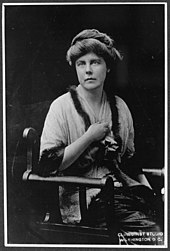Lucy Burns
Lucy Burns (* 28. July 1879 in Brooklyn , New York ; † 22. December 1966 ibid) was an American suffragette and women's rights activist . Together with Alice Paul , with whom she was close friends, and a number of other women, she led the successful struggle for women's suffrage in the USA between 1912 and 1920 . Burns and Paul were the founders of the National Woman's Party (NWP), an American women's rights organization.
Life
Burns was born to an Irish Catholic family. After school she studied at Vassar College and Yale University ; afterwards she worked at short notice as an English teacher . At the age of 26, she went to Germany in 1906 to study languages there for two years. She then returned to New York, where she again worked as a public school teacher. Three years later she traveled to England , where she completed another course at Oxford University .
Here Burns also joined the women's rights organization Women's Social and Political Union ( WSPU ), led by Emmeline and Christabel Pankhurst , where she met Alice Paul. The two women soon enjoyed a deep friendship. Burns and Paul were arrested several times during their protests and also sentenced to prison terms.
In 1910 the two women returned to the United States to breathe new life into the American women's suffrage movement with the radical ideas of the English suffragettes. They joined the National American Woman Suffrage Association ( NAWSA ), but as early as 1913 there was a falling out over the goals and strategies within NAWSA. Carrie Chapman Catt, chairwoman of NAWSA, followed a moderate course and relied on achieving women's suffrage at the federal level through the right to vote in the individual states. Burns and Paul, on the other hand, were of the opinion that they should fight a direct fight for the right to vote at the federal level and, if necessary, use radical methods of protest. A women's parade organized by Burns and Paul in Washington, DC in 1913 ended in disaster as the police failed to prevent violent attacks on women by the public, but it finally got the women's rights activists the attention they needed from the press.
Burns and Paul split shortly afterwards with the Congressional Union for Women Suffrage ( CUWS ), previously a working group of NAWSA, from this. The radical NWP emerged from the CUWS in 1915. Starting in 1916, the NWP organized regular vigils in front of the White House, in which they demanded women's suffrage at the federal level.
When the USA entered the First World War , the situation of the NWP suffragettes worsened. Their vigils in front of the White House were insulted as traitors, some were physically assaulted and arrested by the police. Lucy Burns, Alice Paul and 33 other women were sentenced to several months' imprisonment on flimsy grounds in October 1917 and imprisoned under extreme conditions in the Occoquan Workhouse Women's Prison (now the Lorton Correctional Complex ). The women arrested immediately went on hunger strikes and claimed political prisoner status. The prison authorities responded with solitary confinement and brutal force-feeding.
When the press found out about the conditions in which the women's rights activists were detained, it began to report extensively. Protests against the treatment of women in prison rose, and even the hitherto reticent NAWSA declared war on the government. As a result, the imprisoned NWP activists were released from custody at the end of November 1917. The sentences were later declared unconstitutional by the US Supreme Court .
Lucy Burns held the record for convictions and imprisonment for the struggle for women's suffrage. No other known suffragette has been in prison more than she.
After the 19th Amendment to the United States Constitution was ratified on August 26, 1920 , Burns withdrew from politics to live with her family. She found her final resting place in Holy Cross Cemetery in Brooklyn .
useful information
The story of the struggle for the 19th amendment to the Constitution was filmed in 2004 by the director Katja von Garnier under the title Iron Jawed Angels . Australian actress Frances O'Connor played the role of Lucy Burns.
literature
- Eleanor Clift: Founding Sisters and the Nineteenth Amendment. Hoboken, NJ 2003: John Wiley & Sons, Inc.
- Linda G. Ford: Iron Jawed Angels. The Suffrage Militancy of the National Woman's Party 1912-1920. Lanham, New York, London 1991: University Press of America.
- Doris Stevens: Jailed for Freedom. New York 1920: Boni & Liveright.
- Victor Grossman : Rebel Girls: Portraits of 34 American Women . Cologne: Papyrossa, 2012, pp. 158–171
Web links
- Lucy Burns in the database of Find a Grave (English)
| personal data | |
|---|---|
| SURNAME | Burns, Lucy |
| BRIEF DESCRIPTION | American suffragette and suffragette |
| DATE OF BIRTH | July 28, 1879 |
| PLACE OF BIRTH | Brooklyn , New York |
| DATE OF DEATH | December 22, 1966 |
| Place of death | Brooklyn , New York |

